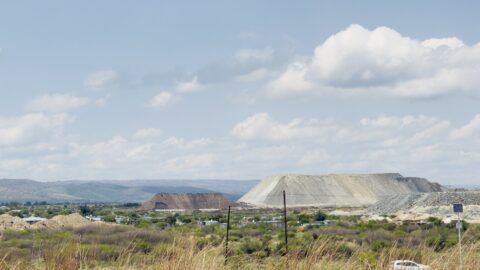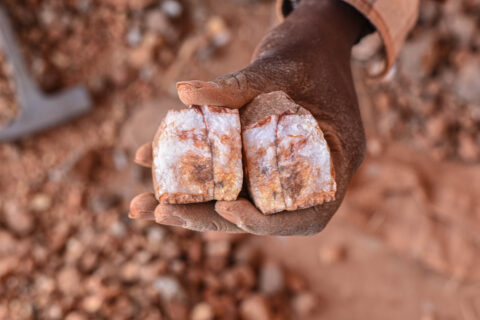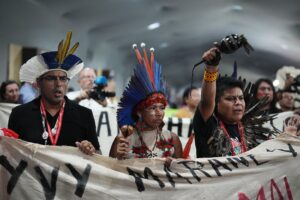Welcome to Carbon Brief’s Cropped.
We handpick and explain the most important stories at the intersection of climate, land, food and nature over the past fortnight.
Key developments
G7 eyes food progress
ITALY MEETING: The Group of Seven (G7) nations met in Italy last week to discuss a range of issues spanning war and hunger to climate change and energy. The summit saw the seven major economies launch a new initiative for tackling hunger, Reuters reported. Known as the G7 Apulia Food Systems Initiative (AFSI) – named after the Southern Italian region where the summit took place – the proposal aims to “overcome structural barriers to food security and nutrition”, according to a declaration published after the event. According to the newswire, the initiative will focus on low-income countries and support projects in Africa, “one of the top priorities under Italy’s rotating G7 presidency this year”. It added that details of the scheme will be agreed by G7 development ministers in the coming months.
-
Sign up to Carbon Brief’s free “Cropped” email newsletter. A fortnightly digest of food, land and nature news and views. Sent to your inbox every other Wednesday.
AFRICA LEFT OUT: Despite having a focus on Africa, agricultural leaders from the continent told Reuters they were not consulted about the new scheme. Ibrahima Coulibaly, president of the West African Network of Peasants and Agricultural Producers, told the newswire: “It is missing family farmers organisations that have not been involved even though small-scale producers will be key to its success.” In African Arguments, Madagascar’s agricultural minister Suzelin Rakotoarisolo Ratohiarijaona was also critical of the lack of involvement of African smallholder farmers in the new scheme, saying: “It’s telling that the Apulia Initiative was developed without their input. If this doesn’t change, it can’t hope to understand or address the daily challenges they face.” He added that the scheme must channel new finance towards grassroots groups and “encourage a shift to more diverse and nature-friendly forms of agriculture”.
‘ZERO’ HARVESTS: The new initiative came as the chief officer of the World Food Programme told BBC News that parts of Africa, as well as the Middle East and Latin America, are now unable to sustain crops due to constant floods and droughts, leaving people completely reliant on humanitarian aid. WFP director Martin Frick told the broadcaster that some of the poorest regions had now reached a tipping point of having “zero” harvests left, as “extreme weather was pushing already degraded land beyond use”. In the east African nation of Burundi, months of heavy rain and flooding has left 10% of all farmland unusable, Frick told BBC News. In the Darfur region of Sudan, cereal crop yields are 78% below the average for the previous five-year average amid drought and civil war, he added.
Food price spikes continue
MULTIPLE CROPS AND CAUSES: Consumers have recently experienced sustained increases in the prices of a range of foods. These price spikes have been attributed to various factors, ranging from climate change and harmful agricultural practices to the international economy and geopolitical tensions. Carbon Brief has just published an article that gathers the views of experts in the agrifood sector on the major causes of this global problem that is already putting pressure on producers, intermediaries and consumers.
CLIMATE-RELATED IMPACTS: Extreme weather events and diseases are hampering harvests and driving up orange prices in Brazil and Florida, Axios reported. The outlet added that in Florida, citrus production has declined 3% on average annually since 2003 and that, according to the International Monetary Fund, the price of oranges globally rose from $2.76 in 2023 to $3.68 in April this year. Prof Andy Challinor, professor of climate impacts at the University of Leeds, told Carbon Brief that “climate change is beginning to outpace us because it is interacting with our complex interrelated economic and food systems”.
CONFLICT REPERCUSSIONS: Dr Rob Vos, director for markets, trade and institutions at the International Food Policy Research Institute, told Carbon Brief that the highest inflation rates have been seen in countries with food systems “disrupted by intensified conflict”, such as Ethiopia, Gaza, Haiti and Sudan. He added that countries with macroeconomic constraints and weak currencies, such as Argentina, Venezuela and Turkey, are also particularly hard-hit. Bloomberg reported that access to agricultural land and workforce reduction due to the war in Gaza has caused Israel’s 29 largest food companies to increase their prices by as much as 30% since January.
UNSUSTAINABLE FARMING: Levi Sucre, coordinator of the Mesoamerican Alliance of Peoples and Forests, told Carbon Brief that overexploitation of land and the use of agrochemicals have increased the demand for fertilisers and the costs of production. For instance, Dr Innocent Okuku, executive secretary of the West African Fertiliser Association, told the Nigerian newspaper Daily Trust that application of fertilisers by smallholder farmers “is getting lower because of the issues around availability and cost”. The most affected are “people with the least resources”, says Sucre. Amongst those “highly vulnerable to food insecurity” are small island developing states, given that less than 1% of their land is devoted to agriculture, 70% of them face the risk of water scarcity and all have lost almost 7% of their agricultural GDP to climate-related disasters, Forbes reported.
Spotlight
Progress on agrifood systems at Bonn
In this spotlight, Carbon Brief explores the progress made regarding agriculture and food security at the recent Bonn climate talks.
The UN Framework Convention on Climate Change (UNFCCC) formally addresses issues and works towards solutions in agriculture and food systems through the Sharm el-Sheikh joint work on implementation of climate action on agriculture and food security (SSJW).
When SSJW negotiations ended at COP28 in Dubai, several experts told Carbon Brief that those outcomes had been disastrous, with the only tangible result of the summit being an “informal note”, which “essentially means, ‘we talked, we’ll talk again’”, Teresa Anderson, global climate justice lead at ActionAid, told Carbon Brief at the time.
The major sticking points at COP28 were the subject matter of a series of workshops to be held under the SSJW umbrella and the creation of a “coordination group” to oversee the implementation of the recommendations from those workshops.
‘Surprisingly sensible’
In contrast to COP28, this round of negotiations at Bonn were “surprisingly sensible”, Anderson said. Marie Cosquer, an advocacy analyst at Action Against Hunger, told Carbon Brief that “the vibe was nothing like Dubai” and the “parties started to engage constructively from the beginning”.
To begin with, Cosquer said, a “non-paper” with proposals, circulated by the EU negotiators ahead of the negotiations, allowed parties to react and “slowly became a way forward for consensus”. In addition, the G77 plus China negotiating group – who had advocated strenuously for the coordination group in Dubai – took a less hardline stance on the creation of the group.
The negotiators ultimately agreed upon two workshop topics: one on “systemic and holistic approaches to implementation of climate action on agriculture, food systems and food security” and the other on “progress, challenges and opportunities related to identifying needs and accessing means of implementation for climate action in agriculture and food security”.
Roadmap
The draft conclusions from Bonn also provide a roadmap for the remainder of the SSJW’s mandate, which runs to COP31 in November 2026. It lays out that the online portal, where parties will be able to upload their submissions for each workshop, should be developed over the next five months and presented at COP29 in November.
Clement Metivier, acting head of international advocacy at WWF-UK, said the roadmap was an “important and positive breakthrough”. It represented a “prime opportunity for governments to prioritise systemic and holistic approaches to transforming our food systems and make them healthy, resilient and equitable”, he added:
“There is no time to waste.”
News and views
EU RESTORATION LAW: EU ministers have approved the bloc’s nature restoration law, “despite stiff opposition to the plans and threats by Austria that it would seek to annul the outcome of the vote”, the Financial Times reported. The FT said “last-minute changes of heart from Austria and Slovakia” allowed the law to pass. However, the vote from Austria came from climate minister Leonore Gewessler, a Green party politician, who did not obtain approval from her coalition government partner, the conservative Austrian People’s Party, the FT said. In a letter to Belgium, which is currently holding the EU presidency, Austria’s chancellor Karl Nehammer, from the People’s Party, said Austria’s vote was “unlawful” and that his party would seek criminal charges against Gewessler for “alleged abuse of power”, the FT added.
FLOODS AND FOOD: Flooding in southern Brazil that started last month has caused $2.2bn in damages, including $680m in agricultural losses, according to Brazil Reports. The outlet added that “agribusiness is by far the most affected economic sector”, citing a study that found that the floods could cut agricultural GDP by up to 3.5%. Meanwhile, extreme weather in China is “raising concerns about food security” there, CNN reported. High temperatures and severe drought are impacting the northern part of the country while “heavy rains inundate the south”, the outlet said. It noted that the spring and summer planting seasons have been disrupted in key rice- and wheat-producing regions.
COTTON CROPS: High temperatures are “threatening cotton production” in the world’s fifth-largest cotton producer, Pakistan, Bloomberg reported. Nearly 10% of the total crop in Sindh – “one of the country’s most fertile provinces” – has been damaged by heat already, the outlet added, and “the situation is poised to get worse”. According to the country’s meteorological department, the month of June will bring rapid-onset “flash” drought, which can result in water shortages, wildfire and crop failure. Bloomberg added: “Besides cotton, excessive heat is also affecting sugarcane, exportable fruits like mangoes, citrus, banana and seasonal vegetables like chillies, tomato, potato and some lentils.”
ALGERIA RIOTS: The Associated Press reported that “violent riots erupted in a drought-stricken Algerian desert city last weekend after months of water shortages left taps running dry and forced residents to queue to access water for their households”. In the central Algerian city of Tiaret, “protestors wearing balaclavas set tires aflame and set up make-shift barricades blocking roads to protest their water being rationed”, AP said. It continued: “The unrest followed demands from President Abdelmajid Tebboune to rectify the suffering. At a council of ministers meeting last week, he implored his cabinet to implement ‘emergency measures’ in Tiaret. Several government ministers were later sent to ‘ask for an apology from the population’ and to promise that access to drinking water would be restored.”
Watch, read, listen
MOSQUITOES TO THE RESCUE: NPR reported on how scientists are transporting hundreds of thousands of mosquitoes to Hawaii to try to save their native bird species.
DEEP DIVE: On Last Week Tonight, comedian John Oliver dived into the controversy surrounding deep-sea mining. (Note, unfortunately, this is not available to watch in the UK.)
ANCESTRAL FORESTS: Nautilus chronicled an expedition to Hoh Rainforest in Washington state, “one of the largest old-growth temperate rainforests in the world”.
AFFECTED FISHERMEN: A multimedia story by InfoNile explored the impacts of overexploitation and illegal taxes by militias on fish production in Africa’s Lake Edward.
New science
Communications Earth & Environment
The increasing number of days without sea ice in southern and western Hudson Bay, an inland marginal sea of the Arctic Ocean in Canada, could make the loss of polar bears from this region “inevitable”, even if efforts are pursued to limit future climate change, new research found. The study drew on the latest high-resolution climate models to project the length of the ice-free period in Hudson Bay. The authors said: “Limiting global warming to 2C above pre-industrial levels may prevent the ice-free period from exceeding 183 days…providing some optimism for adult polar bear survival. However, with longer ice-free periods already substantially impacting recruitment, extirpation for polar bears in this region may already be inevitable.”
Intensified future heat extremes linked with increasing ecosystem water limitation
Earth System Dynamics
According to a new study, increasing water stress in land ecosystems will likely amplify the effects of extreme heat on people and wildlife globally. The researchers explained that while heat extremes “are mostly introduced by atmospheric circulation patterns”, they can be mitigated by ecosystems, which can provide a natural cooling service through plant transpiration and soil evaporation when there are ample water supplies. However, when water supplies in ecosystems are limited, heat extremes can be amplified, the new research found. The authors said: “We identify hotspot regions in tropical South America and across Canada and northern Eurasia where relatively strong trends towards increased ecosystem water limitation jointly occur with amplifying heat extremes.”
Early-stage loss of ecological integrity drives the risk of zoonotic disease emergence
Journal of the Royal Society Interface
The emergence of new diseases from animals – known as “zoonotic diseases” – is “strongly linked” to human pressures on biodiversity, new research suggested. The study updated the most comprehensive zoonotic emerging infectious disease event database with the latest reported events to analyse the relationship between new outbreaks and human pressures on ecosystems. The authors said: “We found emerging infectious disease risk was strongly predicted by structural integrity metrics such as human footprint and ecoregion intactness, in addition to environmental variables such as tropical rainforest density and mammal species richness.” Emerging infectious disease events “were more likely to occur in areas with intermediate levels of compositional and structural integrity, underscoring the risk posed by human encroachment into pristine, undisturbed lands”, the authors added.
In the diary
- 17-20 June: 67th meeting of the Global Environment Fund (GEF) council | Washington DC
- 18-21 June: ICLEI (Local governments for sustainability) World Congress 2024 | São Paulo, Brazil
- 19-21 June: G20 third climate and environment sustainability working group meeting | Manaus, Brazil
- 24-26 June: Organisational meeting of the Preparatory Commission for the Entry Into Force of the BBNJ Agreement and the convening of the first meeting of the Conference of the Parties to the agreement | New York City
This is an online version of Carbon Brief’s fortnightly Cropped email newsletter. Subscribe for free here.
Cropped is researched and written by Dr Giuliana Viglione, Aruna Chandrasekhar, Daisy Dunne, Orla Dwyer and Yanine Quiroz. Please send tips and feedback to cropped@carbonbrief.org.
The post Cropped 19 June 2024: Why food prices are spiking; Bonn climate talks; Plunging polar bear populations appeared first on Carbon Brief.
Climate Change
EU refuses to review “strategic” mineral projects for energy transition
The European Commission has rejected requests by green groups to review the status of 16 controversial projects it has designated as “strategic” to shore up the bloc’s supply of critical minerals needed for the energy transition, despite environmental concerns.
Campaigners accused the European Union’s executive arm of being more interested in labelling projects as “strategic” to accelerate their development than ensuring they meet its environmental standards.
Legal experts told Climate Home News that despite the EU’s rhetoric on developing sustainable mining standards, it will be very difficult for local communities and NGOs to use the judicial system to enforce compliance with environmental safeguards.
Earlier this year, the European Commission labelled 47 mineral extraction, processing and recycling projects within EU member states as “strategic“, granting them preferential treatment for gaining permits and easier access to EU funding.
Spanning from the north of Sweden to Portugal and southern Spain, these projects are due to help the EU reach targets for sourcing more of the minerals it needs for clean energy and digital technologies within its own borders in an environmentally friendly way, while reducing its dependence on imports from China.
However, NGOs and local communities have accused the European Commission of a lack of transparency and of failing to engage civil society over the selection of these projects, most of which are in the early stages of development and are yet to obtain the necessary permits or conduct detailed environmental impact assessments.
Civil society groups challenged the decision to include around a third of projects on the strategic list, arguing that the commission had not properly assessed their sustainability. They also cited risks of social and environmental harm and human rights violations.
EU: Environmental compliance lies with member states
In total, 11 requests for review covering 16 of the projects planned within the EU were filed under the Aarhus Regulation, which gives NGOs the right to ask the European Commission to review administrative decisions if they are considered to violate the bloc’s environmental law.
In a single response shared with green groups this week, and seen by Climate Home News, the commission found that the requests to review the projects’ status were “unfounded”.
“A thorough assessment confirmed that all points raised by the NGOs had already been properly addressed during the selection process. All the projects concerned therefore retain their status as strategic projects,” a European Commission spokesperson told Climate Home News. They did not respond to detailed questions about their assessment.
Under the EU’s Critical Raw Materials Act, which was adopted last year, the commission can designate mineral projects as strategic if they meet a shortlist of criteria, including that the project “would be implemented sustainably” and monitor, prevent and minimise environmental and adverse social impacts.
The strategic status can be revoked if projects no longer meet the criteria.
However, the commission said it was not its job to carry out a full and detailed assessment of whether the projects fully comply with EU environmental laws, adding that it is only required to make an “overall assessment”.
Rather, it argued, member states have the responsibility to ensure the projects fully comply with EU environmental standards including impacts on biodiversity and ground water as well as waste management.
The commission also refused to examine the social impacts of the projects on community livelihoods, health and human rights – which could arise from environmental degradation – arguing that this was outside the scope of the review mechanism under the Aarhus Regulation.
Campaigners have strongly criticised the response.
“Cosmetic”sustainability criteria
Ilze Tralmaka, a lawyer at Client Earth, told Climate Home News the commission’s decision showed that the designation of mineral projects as “strategic” doesn’t make them safe or sustainable, despite creating a legal presumption that they serve the public interest and protect public health and safety.
“While on paper, there is mention of sustainability, in practice, it’s almost cosmetic,” she said. “It seems the environmental standards are just briefly looked at and that the policy of declaring these projects as strategic is more important than real engagement with the sustainability criteria.”
Client Earth argues that while securing supplies of minerals for the energy transition is a legitimate goal, the status of strategic project is being “misused” to fast-track questionable mining projects.
Tralmaka said the European Commission should engage where there are “unanswered questions, or if there is credible information about these projects being potentially unsafe”.
Client Earth was part of a group of NGOs that challenged the decision to designate the Barroso lithium project in Portugal as a strategic project.
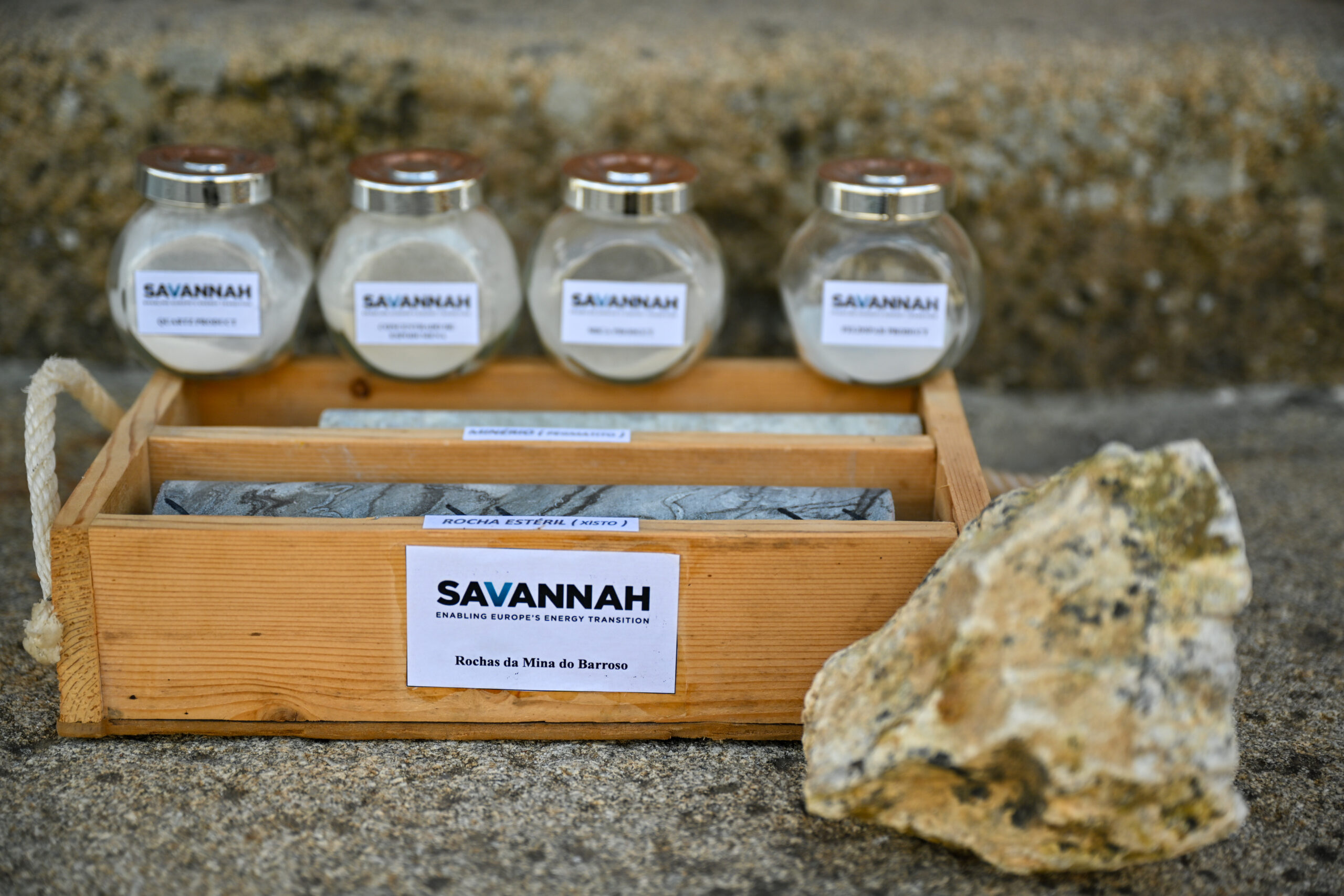

“Textbook example of how not to do a green transition”
London-listed Savannah Resources is planning to dig four open pit mines in the northern Barroso region to extract lithium from Europe’s largest known deposit. The company says it will extract enough lithium every year to produce around half a million batteries for electric vehicles.
However, local groups have staunchly opposed the mining project, citing concerns over waste management and water use as well as the impact of the mine on traditional agriculture in the area.
Earlier this year, a UN committee found that Portugal had failed to respect citizens’ rights to information and public participation in the case of the Barroso project. Portuguese authorities denied the breach.
Efforts to green lithium extraction face scrutiny over water use
The commission said it was satisfied with the project’s overall sustainability credentials and that campaign groups should take a case to their national court if they are concerned about the legality of any project.
“This decision shows that the EU is willing to trade rural lives and irreplaceable landscapes for a political headline,” said Nik Völker of MiningWatch Portugal. “The truth is, the Mina do Barroso mine offers minimal benefits and enormous risks: a textbook example of how not to do a green transition.”
Savannah Resources did not respond to a request for comment.
“Murky” standards make legal challenge hard
Simon Simanovski, a business and human rights attorney with German law firm Günther Rechtsanwälte, has advised dozens of communities affected by projects designated as “strategic” under the EU’s Critical Raw Materials Act over the past year.
For him, the commission’s response creates a disconnect between its role as a decision-making body and the responsibility for enforcing the bloc’s environmental laws, by pushing it to member states. That, he said, creates “murky standards”.
This, he added, will make it “really difficult” to challenge inadequate environmental safeguards through the courts. “It means that there is no effective judicial protection… and that the projects will happen,” he told Climate Home News.
However, Simanovski still expects some campaign groups to try filing a case before the general court of the European Court of Justice to challenge the European Commission’s response and ask it to review its assessment of the projects.
Simanovski represents communities in Serbia that are also challenging the “strategic” designation of the Jadar lithium mine – one of an additional 13 “strategic projects” located outside EU countries – which has seen massive local opposition.
The commission is expected to respond to requests to review those external strategic projects in January.
The post EU refuses to review “strategic” mineral projects for energy transition appeared first on Climate Home News.
EU refuses to review “strategic” mineral projects for energy transition
Climate Change
DeBriefed 28 November 2025: COP30’s ‘frustrating’ end; Asia floods; UK ‘emergency’ climate event
Welcome to Carbon Brief’s DeBriefed.
An essential guide to the week’s key developments relating to climate change.
This week
‘Lukewarm’ end to COP30
BYE BELÉM: The COP30 climate talks in Belém ended last weekend with countries agreeing on a goal to “triple” adaptation finance by 2035 and efforts to “strengthen” climate plans, Climate Home News reported. The final deal “fell short on the global transition away from oil, gas and coal”, the outlet said, as Brazil announced that it would bring forward voluntary roadmaps to phase out fossil fuels and deforestation, before the next COP. It was a “frustrating end” for more than 80 countries who wanted a roadmap away from fossil fuels to be part of the formal COP agreement, BBC News said.
WHAT HAPPENED?: Carbon Brief published its in-depth analysis of all the key outcomes from COP30, spanning everything from negotiations on adaptation, just transition, gender and “Article 6” carbon trading through to a round-up of pledges on various issues. Another Carbon Brief article summed up outcomes around food, forests, land and nature. Also, Carbon Brief journalists discussed the COP in a webinar held earlier this week.
ART OF THE DEAL: The “compromise” COP30 deal – known as the “global mutirão” – “exposed deep rifts over how future climate action should be pursued”, Reuters noted. The “last-ditch” agreement was reached after fossil-fuel wording negotiations between the EU and Saudi Arabia, according to the Guardian. Meanwhile, Carbon Brief revealed the “informal” list of 84 countries said to have “opposed” the inclusion of a fossil-fuel roadmap in the mutirão decision, but analysis of the list exposed contradictions and likely errors.
UNITY, SCIENCE, SENSE: The final agreement received “lukewarm praise”, said the Associated Press. Palau ambassador Ilana Seid, who chaired the coalition of small-island nations, told the newswire: “Given the circumstances of geopolitics today, we’re actually quite pleased…The alternative is that we don’t get a decision and that would have been [worse].” UN climate chief Simon Stiell said that amid “denial, division and geopolitics”, countries “chose unity, science and economic common sense”, reported the Press Trust of India.
Around the world
- Floods and landslides killed more than 200 people in Thailand and Indonesia this week, reported Bloomberg. At least 90 people also died in recent floods in Vietnam, said Al Jazeera.
- New measures to cut energy bills and a “pay-per-mile” electric-vehicle levy were among the announcements in the UK’s budget, said Carbon Brief.
- The Group of 20 (G20) leaders signed off on a declaration “addressing the climate crisis” and other issues, reported Reuters, which had no input from the US who boycotted last week’s G20 summit in South Africa.
- Canadian prime minister Mark Carney signed a deal with the province of Alberta “centred on plans for a new heavy oil pipeline”, said the Guardian, adding that Canadian culture minister and former environment minister, Steven Guilbeault, resigned from cabinet over the deal.
- Greenpeace analysis, covered by Reuters, found that permits for new coal plants in China are “on track to fall to a four-year low” in 2025.
27
The number of hours that COP30 talks went over schedule before ending in Belém last Saturday, making it the 11th-longest UN climate summit on record, according to analysis by Carbon Brief.
Latest climate research
- The risk of night-time deaths during heatwaves increased “significantly” over 2005-15 in sub-Saharan Africa | Science Advances
- Almost half of climate journalists surveyed showed “moderate to severe” symptoms of anxiety | Traumatology
- Lakes experienced “more severe” heatwaves than those in the atmosphere over the past two decades | Communications Earth & Environment
(For more, see Carbon Brief’s in-depth daily summaries of the top climate news stories on Monday, Tuesday, Wednesday, Thursday and Friday.)
Captured
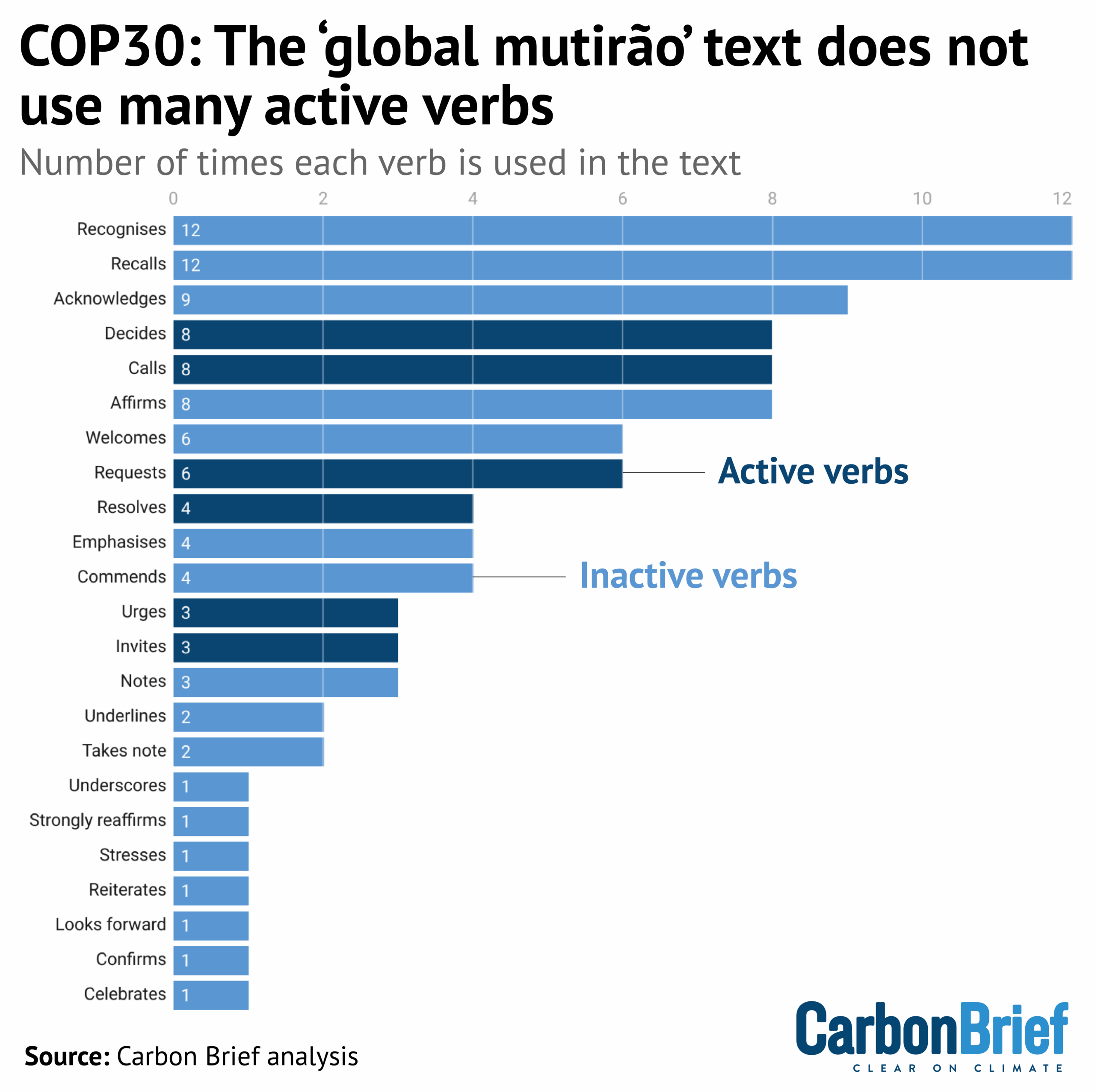
The key COP30 agreement – termed the “global mutirão” – contained 69 inactive verbs, which require no action from countries, compared to 32 active ones. “Recognises”, “recalls” and “acknowledges” were used far more often than more active verbs, such as “decides”, “calls” and “requests”, showed Carbon Brief analysis.
Spotlight
Nine warnings from a UK climate and nature ‘emergency’ briefing
This week, Carbon Brief’s Orla Dwyer reports from an event where experts and campaigners sounded the alarm bell on climate change and nature loss.
Naturalist and broadcaster Chris Packham urged attendees at a climate and nature “emergency briefing” in London yesterday to “listen to the science” on climate change amid a “dangerous wave of misinformation and lies”.
The “first-of-its-kind” event heard from nine experts on the links between climate change, nature loss, health, food production, economics and national security.
Event host, Prof Mike Berners-Lee from Lancaster University, called for a “World War II level of leadership” to tackle the interconnected crises.
Hundreds of people showed up, including Green Party, Labour and Liberal Democrat MPs, leader of the Greens Zack Polanski, musician Brian Eno and actress Olivia Williams.
Here is a snapshot of what the nine speakers said in their short, but stark, presentations.
Prof Kevin Anderson, professor of energy at University of Manchester
Anderson focused on the risks of a warmer world and the sliver of emissions left in the global carbon budget, noting:
“We have to eliminate fossil fuels or temperatures will just keep going up.”
He urged a “Marshall-style” plan – referencing the 1948 post-war US plan to rebuild Europe – to ramp up actions on retrofitting, public transport and electrification.
Prof Nathalie Seddon, professor of biodiversity at University of Oxford
Nature is not a “nice to have”, but rather “critical national infrastructure”, Seddon told attendees. She called for the “need to create an economy that values nature”.
Prof Paul Behrens, British Academy global professor at University of Oxford
Behrens discussed the food security risks from climate change. Impacts such as poor harvests and food price inflation are “barely acknowledge[d]” in agricultural policy, he said.
He also emphasised the “unsustainable” land use of animal agriculture, which “occupies around 85% of total agricultural land” in the UK.
Prof Tim Lenton, chair in climate change and Earth system science at Exeter University
Lenton outlined the “plenty” of evidence that parts of the Earth system are hurtling towards climate tipping points that could push them irreversibly into a new state.
He discussed the possibility of the shutdown of the Atlantic Meridional Overturning Circulation, which he said could cause -20C winters in London. He also noted positive tipping points, such as momentum that led the UK to stop burning coal for electricity last year.
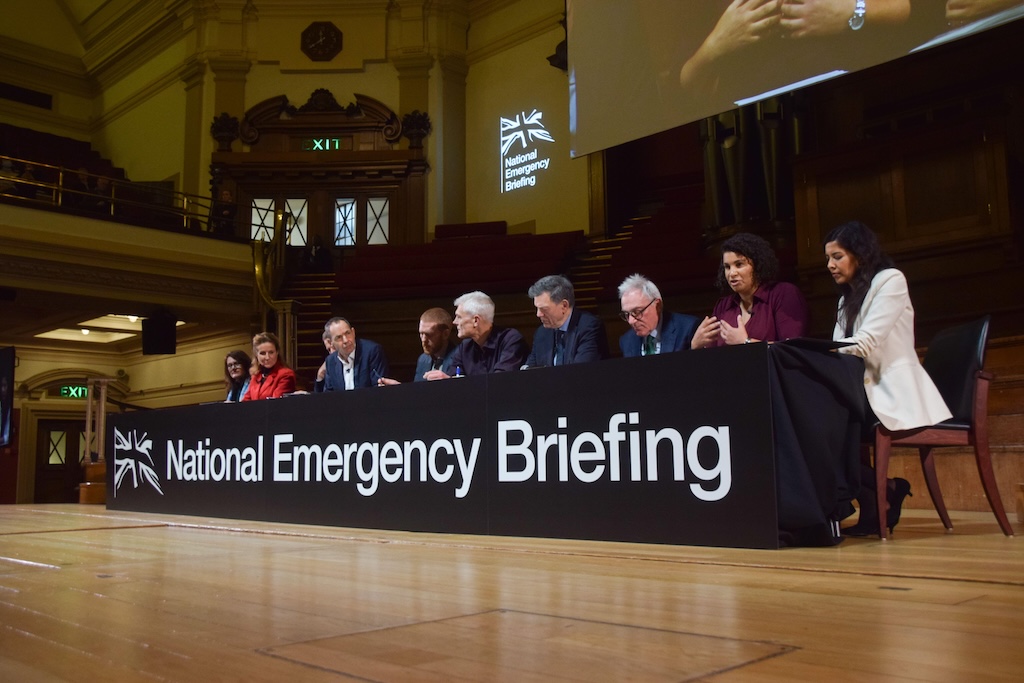
Prof Hayley Fowler, professor of climate change impacts at Newcastle University
One in four properties in England could be at risk of flooding by 2050, Fowler said, and winters are getting wetter.
She discussed extreme weather risks and listed the impacts of floods in recent years in Germany, Spain and Libya, adding:
“These events are not warnings of what might happen in the future. They’re actually examples of what is happening right now.”
Angela Francis, director of policy solutions at WWF-UK
Francis factchecked several claims made against climate action, such as the high cost of achieving net-zero.
She noted that the estimated cost for the UK to achieve net-zero is about £4bn per year, which is less than 0.2% of GDP.
Lieutenant general Richard Nugee, climate and security advisor
Discussing the risks climate change poses to national security, Nugee said:
“Climate change can be thought of as a threat multiplier, making existing threats worse or more frequent and introducing new threats. Climate shocks fuel global instability.”
Tessa Khan, environmental lawyer and executive director of Uplift
Khan said the rising cost of energy in the UK is “turning into a significant political risk for the energy transition”.
She discussed the cost of fossil-fuel dependency and the fact that these fuels cost money to burn, but renewable “input[s], sun or wind [are] free forever”.
Prof Hugh Montgomery, professor of intensive care medicine at University College London
Montgomery discussed the health and economic benefits of climate actions, such as eating less meat and using more public transport, noting:
“The climate emergency is a health emergency – and it’s about time we started treating it as one.”
Watch, read, listen
WATER WORRIES: ABC News spoke to three Iranian women about the impacts of Tehran’s water crisis amid the “worst drought in 60 years”.
CLIMATE EFFORT: The BBC’s Climate Question podcast looked at the main outcomes from COP30 and discussed the “future of climate action” with a team of panelists.
CRIMINAL BEHAVIOUR:New Scientist interviewed criminal psychologist Julia Shaw about the psychology behind environmental crimes.
Coming up
- 24 November-5 December: COP20 on international trade in endangered species of wild fauna and flora, Samarkand, Uzbekistan
- 29-30 November: First part of global youth environment assembly, Nairobi, Kenya
- 3-4 December: Second round of Egyptian parliamentary elections
- 5 December: World soil day, global
Pick of the jobs
- Aldersgate Group, head of policy | Salary: £56,650-£66,950 per year. Location: London
- Ofgem, climate resilience expert | Salary: £61,446-£86,547. Location: Cardiff, Glasgow or London
- Green Climate Fund, integrity risk management lead | Salary: $171,200. Location: Incheon, South Korea
- Isles of Scilly Wildlife Trust, project manager – seabird recovery | Salary: Up to £45,000 per year. Location: Isles of Scilly, UK
DeBriefed is edited by Daisy Dunne. Please send any tips or feedback to debriefed@carbonbrief.org.
This is an online version of Carbon Brief’s weekly DeBriefed email newsletter. Subscribe for free here.
The post DeBriefed 28 November 2025: COP30’s ‘frustrating’ end; Asia floods; UK ‘emergency’ climate event appeared first on Carbon Brief.
DeBriefed 28 November 2025: COP30’s ‘frustrating’ end; Asia floods; UK ‘emergency’ climate event
Climate Change
Revealed: Leak casts doubt on COP30’s ‘informal list’ of fossil-fuel roadmap opponents
A confused – and, at times, contradictory – story has emerged about precisely which countries and negotiating blocs were opposed to a much-discussed “roadmap” deal at COP30 on “transitioning away from fossil fuels”.
Carbon Brief has obtained a leaked copy of the 84-strong “informal list” of countries that, as a group, were characterised across multiple media reports as “blocking” the roadmap’s inclusion in the final “mutirão” deal across the second week of negotiations at the UN climate summit in Belém.
During the fraught closing hours of the summit, Carbon Brief understands that the Brazilian presidency told negotiators in a closed meeting that there was no prospect of reaching consensus on the roadmap’s inclusion, because there were “80 for and 80 against”.
However, Carbon Brief’s analysis of the list – which was drawn up informally by the presidency – shows that it contains a variety of contradictions and likely errors.
Among the issues identified by Carbon Brief is the fact that 14 countries are listed as both supporting and opposing the idea of including a fossil-fuel roadmap in the COP30 outcome.
In addition, the list of those said to have opposed a roadmap includes all 42 of the members of a negotiating group present in Belém – the least-developed countries (LDCs) – that has explicitly told Carbon Brief it did not oppose the idea.
Moreover, one particularly notable entry on the list, Turkey – which is co-president of COP31 – tells Carbon Brief that its inclusion is “wrong”.
Negotiating blocs
COP28, held in Dubai in 2023, had finalised the first “global stocktake”, which called on all countries to contribute to global efforts, including a “transition away from fossil fuels”.
Since then, negotiations on how to take this forward have faltered, including at COP29 in Baku, Azerbaijan, where countries were unable to agree to include this fossil-fuel transition as part of existing or new processes under the UN climate regime.
Ahead of the start of COP30, Brazilian president Luiz Inácio Lula da Silva made a surprise call for “roadmaps” on fossil-fuel transition and deforestation.
While this idea was not on the official agenda for COP30, it had been under development for months ahead of the summit – and it became a key point of discussion in Belém.
Ultimately, however, it did not become part of the formal COP30 outcome, with the Brazilian presidency instead launching a process to draw up roadmaps under its own initiative.
This is because the COP makes decisions by consensus. The COP30 presidency insisted that there was no prospect of consensus being reached on a fossil-fuel roadmap, telling closed-door negotiations that there were “80 for and 80 against”.
The list of countries supporting a roadmap as part of the COP30 outcome was obtained by Carbon Brief during the talks. Until now, however, the list of those opposed to the idea had not been revealed.
Carbon Brief understands that this second list was drawn up informally by the Brazilian presidency after a meeting attended by representatives of around 50 nations. It was then filled out to the final total of 84 countries, based on membership of negotiating alliances.
The bulk of the list of countries opposing a roadmap – some 39 nations – is made up of two negotiating blocs that opposed the proposal for divergent reasons (see below). Some countries within these blocs also held different positions on why – or even whether – they opposed the roadmap being included in the COP30 deal.
These blocs are the 22-strong Arab group – chaired in Belém by Saudi Arabia – and the 25 members of the “like-minded developing countries” (LMDCs), chaired by India.
For decades within the UN climate negotiations, countries have sat within at least one negotiating bloc rather than act in isolation. At COP30, the UN says there were 16 “active groups”. (Since its invasion of Ukraine, Russia has not sat within any group.)
The inclusion on the “informal list” (shown in full below) of both the LMDCs and Arab group is accurate, as confirmed by the reporting of the International Institute for Sustainable Development’s Earth Negotiations Bulletin (ENB), which is the only organisation authorised to summarise what has happened in UN negotiations that are otherwise closed to the media.
Throughout the fortnight of the talks, both the LMDCs and Arab group were consistent – at times together – in their resistance to proscriptive wording and commitments within any part of the COP30 deal around transitioning away from fossil fuels.
But the reasons provided were nuanced and varied and cannot be characterised as meaning both blocs simply did not wish to undertake the transition – in fact, all countries under the Paris Agreement had already agreed to this in Dubai two years ago at COP28.
However, further analysis by Carbon Brief of the list shows that it also – mistakenly – includes all of the members of the LDCs, bar Afghanistan and Myanmar, which were not present at the talks. In total, the LDCs represented 42 nations in Belém, ranging from Bangladesh and Benin through to Tuvalu and Tanzania.
Some of the LDC nations had publicly backed a fossil-fuel roadmap.
‘Not correct’
Manjeet Dhakal, lead adviser to the LDC chair, tells Carbon Brief that it is “not correct” that the LDCs, as a bloc, opposed a fossil-fuel roadmap during the COP30 negotiations.
He says that the group’s expectations, made public before COP, clearly identified transitioning away from fossil fuels as an “urgent action” to keep the Paris Agreement’s 1.5C goal “within reach”. He adds:
“The LDC group has never blocked a fossil-fuel roadmap. [In fact], a few LDCs, including Nepal, have supported the idea.”
Dhakal’s statement highlights a further confusing feature of the informal list – 14 countries appear on both of the lists of supporters and opposers. This is possible because many countries sit within two or more negotiating blocs at UN climate talks.
For example, Kiribati, Solomon Islands and Tuvalu are members of both the “alliance of small island states” (AOSIS) and the LDCs.
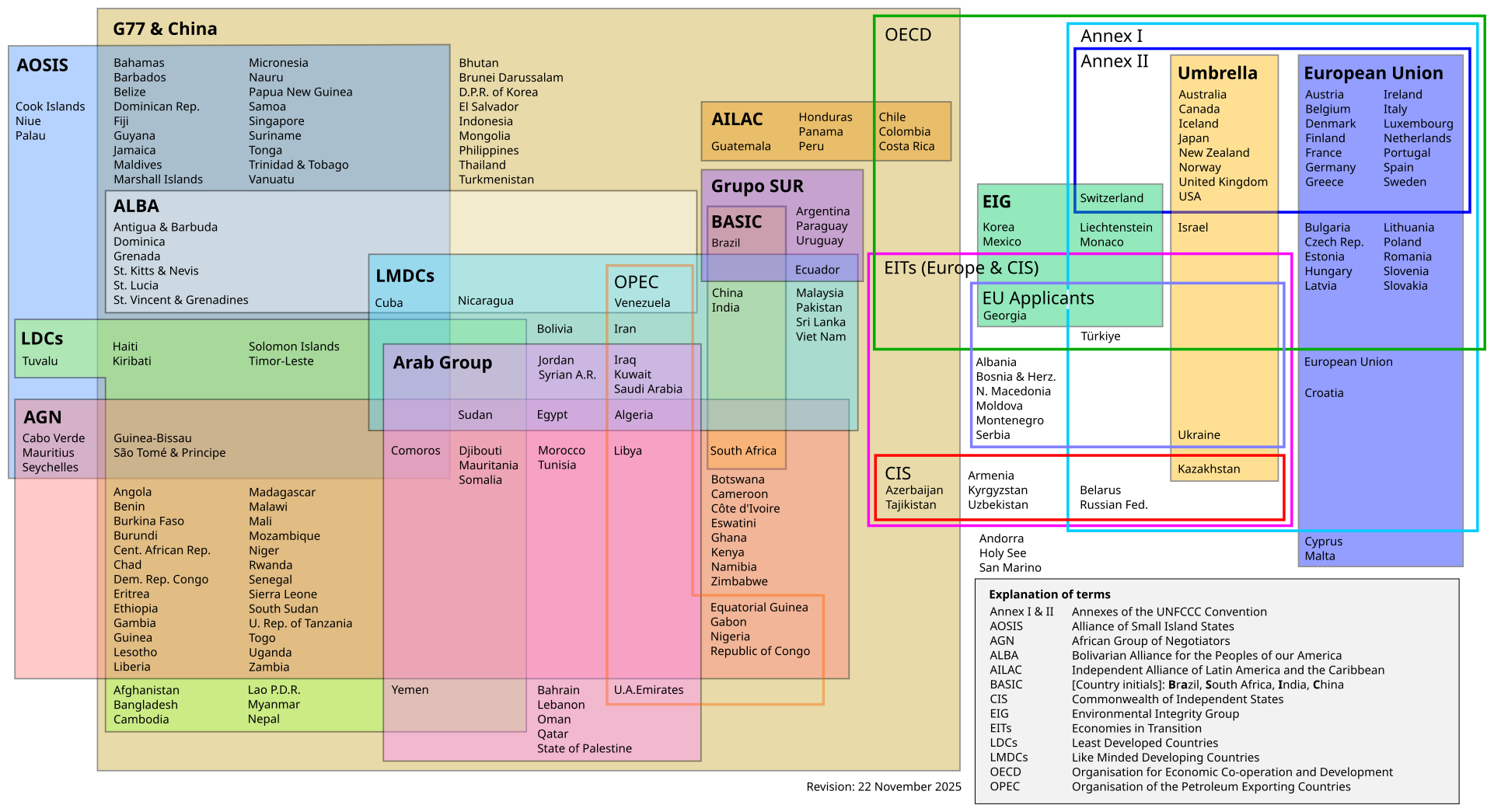
As is the case with the “informal list” of opposers, the list of supporters (which was obtained by Carbon Brief during the talks) is primarily made up of negotiating alliances.
Specifically, it includes AOSIS, the “environmental integrity group” (EIG), the “independent association of Latin America and the Caribbean” (AILAC) and the European Union (EU).
In alphabetical order, the 14 countries on both lists are: Bahrain; Bulgaria; Comoros; Cuba; Czech Republic; Guinea-Bissau; Haiti; Hungary; Kiribati; Nepal; Sierra Leone; Solomon Islands; Timor-Leste; and Tuvalu.
This obvious anomaly acts to highlight the mistaken inclusion of the LDCs on the informal list of opposers.
The list includes 37 of the 54 nations within the Africa group, which was chaired by Tanzania in Belém.
But this also appears to be a function of the mistaken inclusion of the LDCs in the list, many of which sit within both blocs.
Confusion
An overview of the talks published by the Guardian this week reported:
“Though [Brazil’s COP30 president André Corrêa do Lago] told the Guardian [on 19 November] that the divide over the [roadmap] issue could be bridged, [he] kept insisting 80 countries were against the plan, though these figures were never substantiated. One negotiator told the Guardian: ‘We don’t understand where that number comes from.’
“A clue came when Richard Muyungi, the Tanzanian climate envoy who chairs the African group, told a closed meeting that all its 54 members aligned with the 22-member Arab Group on the issue. But several African countries told the Guardian this was not true and that they supported the phaseout – and Tanzania has a deal with Saudi Arabia to exploit its gas reserves.”
Adding to the confusion, the Guardian also said two of the most powerful members of the LMDCs were not opposed to a roadmap, reporting: “China, having demurred on the issue, indicated it would not stand in the way [of a roadmap]; India also did not object.”
Writing for Climate Home News, ActionAid USA’s Brandon Wu said:
“Between rich country intransigence and undemocratic processes, it’s understandable – and justifiable – that many developing countries, including most of the Africa group, are uncomfortable with the fossil-fuel roadmap being pushed for at COP30. It doesn’t mean they are all ‘blockers’ or want the world to burn, and characterising them as such is irresponsible.
“The core package of just transition, public finance – including for adaptation and loss and damage – and phasing out fossil fuels and deforestation is exactly that: a package. The latter simply will not happen, politically or practically, without the former.”
Carbon Brief understands that Nigeria was a vocal opponent of the roadmap’s inclusion in the mutirão deal during the final hours of the closed-door negotiations, but that does not equate to it opposing a transition away from fossil fuels. This is substantiated by the ENB summary:
“During the…closing plenary…Nigeria stressed that the transition away from fossil fuels should be conducted in a nationally determined way, respecting [common, but differentiated responsibilities and respective capabilities].”
The “informal list” of opposers also includes three EU members – Bulgaria, the Czech Republic and Hungary.
The EU – led politically at the talks by climate commissioner Wopke Hoekstra, but formally chaired by Denmark – was reportedly at the heart of efforts to land a deal that explicitly included a “roadmap” for transitioning away from fossil fuels.
Carbon Brief understands that, as part of the “informal intelligence gathering” used to compile the list, pre-existing positions on climate actions by nations were factored in rather than only counting positions expressed at Belém. For example, Hungary and the Czech Republic were reported to have been among those resisting the last-minute “hard-fought deal” by the EU on its 2040 climate target and latest Paris Agreement climate pledge.
(Note that EU members Poland and Italy did not join the list of countries supporting a fossil-fuel roadmap at COP30.)
The remaining individual nations on the informal list either have economies that are heavily dependent on fossil-fuel production (for example, Russia and Brunei Darussalam), or are, like the US, currently led by right-leaning governments resistant to climate action (for example, Argentina).
Turkey is a notable inclusion on the list because it was agreed in Belém that it will host next year’s COP31 in Antalya, but with Australia leading the negotiation process. In contrast, Australia is on the 85-strong list of roadmap supporters.
However, a spokesperson for Turkey’s delegation in Belem has told Carbon Brief that it did not oppose the roadmap at COP30 and its inclusion on the list is “wrong”.
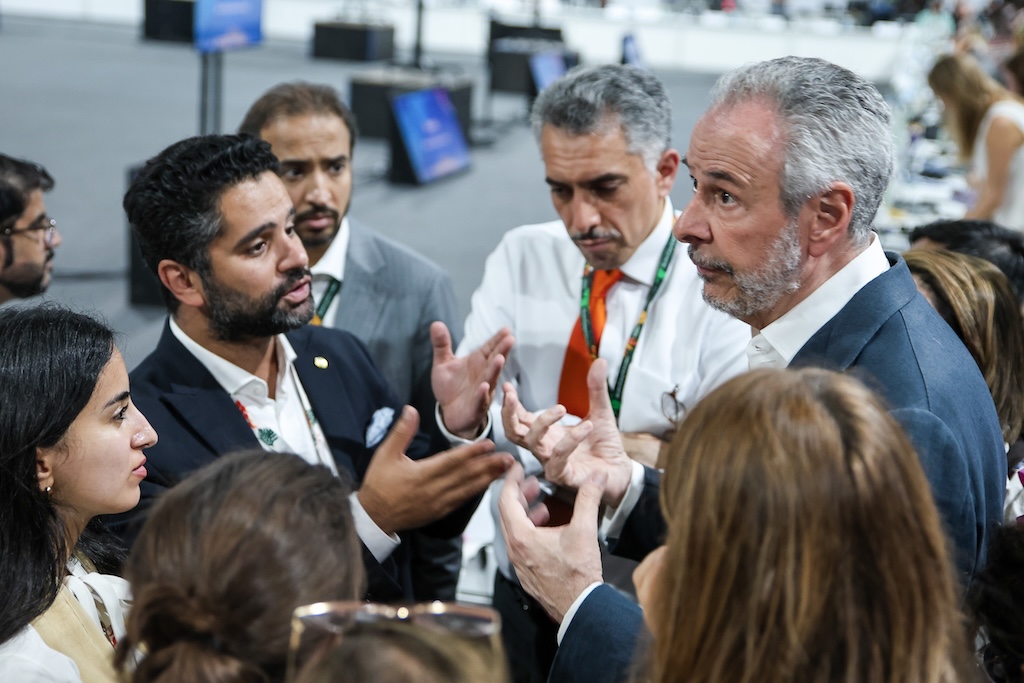
Media characterisations
Some media reporting of the roadmap “blockers” sought to identify the key proponents.
For example, the Sunday Times said “the ‘axis of obstruction’ – Saudi Arabia, Russia and China – blocked the Belém roadmap”.
Agence France-Presse highlighted the views of a French minister who said: “Who are the biggest blockers? We all know them. They are the oil-producing countries, of course. Russia, India, Saudi Arabia. But they are joined by many emerging countries.”
Reuters quoted Vanuatu’s climate minister alleging that “Saudi Arabia was one of those opposed”.
The Financial Times said “a final agreement [was] blocked again and again by countries led by Saudi Arabia and Russia”.
Bloomberg said the roadmap faced “stiff opposition from Arab states and Russia”.
Media coverage in India and China has pushed back at the widespread portrayals of what many other outlets had described as the “blockers” of a fossil-fuel roadmap.
The Indian Express reported:
“India said it was not opposed to the mention of a fossil-fuel phaseout plan in the package, but it must be ensured that countries are not called to adhere to a uniform pathway for it.”
Separately, speaking on behalf of the LMDCs during the closing plenary at COP30, India had said: “Adaptation is a priority. Our regime is not mitigation centric.”
China Daily, a state-run newspaper that often reflects the government’s official policy positions, published a comment article this week stating:
“Over 80 countries insisted that the final deal must include a concrete plan to act on the previous commitment to move beyond coal, oil, and natural gas adopted at COP28…But many delegates from the global south disagreed, citing concerns about likely sudden economic contraction and heightened social instability. The summit thus ended without any agreement on this roadmap.
“Now that the conference is over, and emotions are no longer running high, all parties should look objectively at the potential solution proposed by China, which some international media outlets wrongly painted as an opponent to the roadmap.
“Addressing an event on the sidelines of the summit, Xia Yingxian, deputy head of China’s delegation to COP30, said the narrative on transitioning away from fossil fuels would find greater acceptance if it were framed differently, focusing more on the adoption of renewable energy sources.”
Speaking to Carbon Brief at COP30, Dr Osama Faqeeha, Saudi Arabia’s deputy environment minister, refused to be drawn on whether a fossil-fuel roadmap was a red line for his nation, but said:
“I think the issue is the emissions, it’s not the fuel. And our position is that we have to cut emissions regardless.”
Neither the Arab group nor the LMDCs responded to Carbon Brief’s invitation to comment on their inclusion on the list.
The Brazilian COP30 presidency did not respond at the time of publication.
While the fossil-fuel roadmap was not part of the formal COP30 outcome, the Brazilian presidency announced in the closing plenary that it would take the idea forward under its own initiative, drawing on an international conference hosted in Colombia next year.
Corrêa do Lago told the closing plenary:
“We know some of you had greater ambitions for some of the issues at hand…As president Lula said at the opening of this COP, we need roadmaps so that humanity, in a just and planned manner, can overcome its dependence on fossil fuels, halt and reverse deforestation and mobilise resources for these purposes.
“I, as president of COP30, will therefore create two roadmaps, one on halting and reverting deforestation, another to transitioning away from fossil fuels in a just, orderly and equitable manner. They will be led by science and they will be inclusive with the spirit of the mutirão.
“We will convene high level dialogues, gathering key international organisations, governments from both producing and consuming countries, industry workers, scholars, civil society and will report back to the COP. We will also benefit from the first international conference for the phase-out of fossil fuels, scheduled to take place in April in Colombia.”
Fossil-fuel roadmap
‘Supporters’
Both ‘supporter’ and ‘opposer’
‘Opposers’
Additional reporting by Daisy Dunne.
The post Revealed: Leak casts doubt on COP30’s ‘informal list’ of fossil-fuel roadmap opponents appeared first on Carbon Brief.
Revealed: Leak casts doubt on COP30’s ‘informal list’ of fossil-fuel roadmap opponents
-
Climate Change4 months ago
Guest post: Why China is still building new coal – and when it might stop
-
Greenhouse Gases4 months ago
Guest post: Why China is still building new coal – and when it might stop
-
Climate Change2 years ago
Spanish-language misinformation on renewable energy spreads online, report shows
-

 Greenhouse Gases2 years ago
Greenhouse Gases2 years ago嘉宾来稿:满足中国增长的用电需求 光伏加储能“比新建煤电更实惠”
-
Climate Change Videos2 years ago
The toxic gas flares fuelling Nigeria’s climate change – BBC News
-

 Climate Change2 years ago
Climate Change2 years ago嘉宾来稿:满足中国增长的用电需求 光伏加储能“比新建煤电更实惠”
-

 Carbon Footprint2 years ago
Carbon Footprint2 years agoUS SEC’s Climate Disclosure Rules Spur Renewed Interest in Carbon Credits
-
Renewable Energy5 months ago
US Grid Strain, Possible Allete Sale



